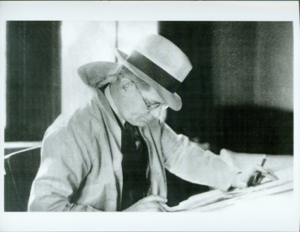An Intern’s Perspective on the Legacy of Jay N. Darling
Sigrid Lampe, August – September, 2020
I have found it challenging, yet rewarding, to have been a part of The Jay N. Darling Legacy Center internship program. My short internship has helped me become more aware of the environmental impacts that were occurring during Darling’s time and how those impacts have contributed to issues that are present today. As an Environmental Studies major in college, I never learned about Jay N. Darling, which was very surprising. With this realization, I wanted to share my thoughts about Jay N. “Ding” Darling, who has helped inspire and educate many generations about the environment as well as problems within society. Darling helped to shape modern day conservation …..when creating cartoons, he expressed and promoted conservational adversity and ultimately raised environmental concerns nationwide.

Darling’s accomplishments in conservation and environmental issues will long be remembered. Darling was responsible for creating the first Federal Duck Stamp and initiated the Federal Duck Stamp Program, which has now raised more than $1 billion to acquire habitat for national wildlife refuges in all fifty states. He established the Migratory Bird Conservation Commission. During President Franklin Roosevelt’s era, Darling was asked to become head of the U.S. Biological Survey, the forerunner of the U.S. Fish and Wildlife Service. The J. N. “Ding” Darling National Wildlife Refuge on Sanibel Island, Florida, was created as Darling secured the land from being sold to developers. Lake Darling in Iowa was named after Jay N. Darling as an embodiment of a new awareness of conservation and a spirit of collaborative achievement he had worked so hard to promote. There are 28 National Wildlife Refuges that he helped create throughout the USA. Ultimately, Darling was responsible for collaborative efforts in partnerships to raise awareness for the wise use of natural resources. To top it off, Darling won two Pulitzer Prizes–one in 1924 and the other in 1943.
Educating the next generation about conservation was very important to Darling. He believed that it would potentially create a more environmentally cautious generation. Darling devoted his talents to conservation education, which started with the development of institutes and programs. His hard work and dedication brought public awareness to conservation through starting the Cooperative Fish and Wildlife Research Unit Program (that now has units in 40 different universities), creating the Federal Duck Stamp Program, helping secure the National Wildlife Refuge System, and establishing the National Wildlife Federation. Furthermore, Darling and Gardner Cowles, publisher of the Des Moines Register and Tribune, gave monetary contributions to Piney Woods School in Piney Woods, Mississippi, which helped the school continue to educate African Americans who were in poverty. It truly blew me away when I learned that he helped bring these programs into existence and gave contributions to schools in need. Darling’s efforts, funding, and leadership paved the way for the next generation to bring action and attentiveness to the movement of conservation.
At the beginning of his life, Darling wanted to become a doctor, not an editorial cartoonist. However, during Darling’s time in Beloit College in Wisconsin, he became an art editor for the yearbook. That’s when he started to write his name as D’ing but ended up transforming it into “Ding,” which became his famous signature for all of his cartoon creations. In Jay Darling’s words, he explained, “The apostrophe stood for the ‘arl’ which were left out in order to make a funnier looking signature—and, in addition, to conceal my identity.” Unfortunately, “Ding”ended up being suspended for a year. Many believed it was for creating a humorous cartoon that included the faculty members; however, it was due to him not taking school seriously.
But in many ways, this setback in his life was the beginning of his legacy. Since Darling was always fond of creating cartoons and other artwork, he decided to apply at the Des Moines Register and Leader where he met Gardner Cowles who was looking to build the Register and Leader to be at a more competitive level. Darling was able to provide exactly that with his work. Cowles gave Darling free reign in his creations, bringing his own expression to the newspaper. This type of atmosphere allowed Darling to truly express his beliefs and create work that was undeniably controversial, yet groundbreaking. It did not take long for Darling’s talents to become widely displayed, which eventually took him to New York to join the S. C. Journal. However, Darling never felt that it was the right fit for his talents and decided to go back to Des Moines. At this time, Cowles made the decision to put Darling on the board at the Register and Leader.
Darling’s whimsical side spilled over into other aspects of his life, such as his remodeled house in Des Moines, Iowa. Toni Kiernan, whose family rented Darling’s home back in 1951, explained that “his house was like a fairytale growing up. There were hidden panels, stairs, and doors that created a magical atmosphere. The living room was shaped like a cathedral, and there was a large flower garden in the backyard.” However, the one thing that she remembers the most as she got older was Darling’s artwork all around the house. She found it mesmerizing, and it made her appreciate art as well as the way Darling contributed to society. Darling’s house was a place that she and her family will never forget. (Continued)